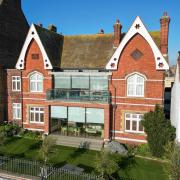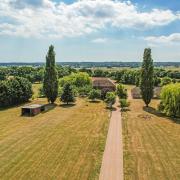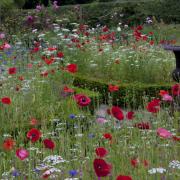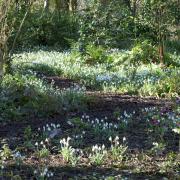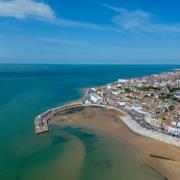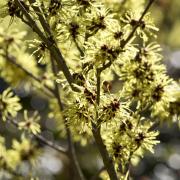Home to the Dawes family since 1695, Mount Ephraim near Faversham is one of Kent’s treasured, privately-owned estates. Set within some 800 acres, the gardens, which enfold the imposing house and were first laid out in the early 1900s by Willie and Jeanie Dawes, have been added to over the following generations. The Edwardian feel across the ten acres of gardens remains, with some contemporary touches that complement the whole. Visitors can enjoy vistas over the lake, long-flowering herbaceous borders, whimsical topiary, terraces of fragrant roses, a Japanese rock garden, mature trees in the arboretum and an unexpected miz-maze, based on a medieval labyrinth, and designed by Sarah Morgan in 2004 with shimmering ornamental grasses and perennials.

As with many estates the house and gardens suffered through wartime neglect and damage, going from having a permanent staff of twelve gardeners, plus an ‘improvements’ gang of twenty to a much-reduced team. From the 1950s Bill Dawes and his wife Mary, who was affectionately known as Miz, took on the task of restoration with enthusiasm. Mary was particularly passionate about gardening and was involved with the running of the garden up to her death in 2009, at the age of 93. To help with the upkeep of the gardens Mary and her son Sandys with his wife Lesley made the decision to open the gardens to the public in 1985.
Today Sandys and Lesley, along with their son Will and daughter Lucy, continue the legacy of this very personal garden, aided by two full-time gardeners, with some occasional part-time and volunteer help. It is a real family-effort, with each having distinct roles. Will is ultimately in charge of overseeing everything, but his domain is very much running the fruit farm with Lucy running all of the house, events and gardens operations. Sandys and Lesley are meant to be retired, but are still partners in the business and are still very active in the gardens, with Lesley doing all of the pots and Sandys tending to the "Miz Maze" most days throughout the garden season.

Summer highlights to discover include the peak of the colourful mixed borders, with their mix of traditional stalwarts; scented roses still blooming in the Millennium rose garden, and the textures wafting in the large circular "Miz Maze", alive with bees and butterflies - Sandys’ favourite part of the gardens. 'This "Catherine Wheel" of contrasting colours has eight sections and each has a mix of grasses and perennials, with its structure remaining throughout the year. My favourite sections are Miscanthus "Morning Light", with veronicastrum, rudbeckia with Stipa gigantea and Echinacea purpurea and Eupatorium purpureum,” he says. Regular dead-heading of spent blooms keeps the flowering going across the garden areas through summer into autumn ,when seasonal foliage and berries continue the show. Wandering the gardens gives you both a sense of the past and the new; from characteristics of the Edwardian style that still influences us today, to the bio-diverse, landscape movement that works with nature.

To know
• Mount Ephraim Gardens, Hernhill, Faversham, ME13 9TX
Open to 30 Sept, Wednesdays to Sundays and BHM (11-5)
Adm £8, children (4-16) £3
mountephraimgardens.co.uk
Get the look

• Use topiary to punctuate and engage the viewer
• Grow long-flowering perennials and annuals
• To keep the colour going include plenty of high- and late-summer choices that cope well with the weather
• Use a handful of ultra-reliable, perennial workhorses. There is a plethora of brilliant flowers to select from, such as dahlias, hydrangeas, cleome, late roses, fuchsias, agapanthus, penstemons and the daisy-like forms of heleniums, rudbeckias, anthemis and echinacea
• Deadhead to encourage further blooms
• Create different garden areas, each with a theme
Characteristics of the Edwardian garden style:

• Formal by the house and merging to informal areas and view beyond
• Arts and Crafts style, appreciating handmade craftsmanship
• Topiaries of whimsical shapes
• More relaxed than the Victorian look
• Hedges, terraces, structures
• Natural materials
• Ebullient, colour-themed planting
• A rural idyll with a mix of man-made control and naturalness
• Still influences us today, and has become known as 'the English style'









